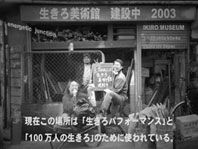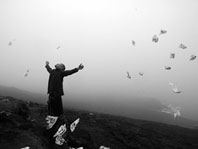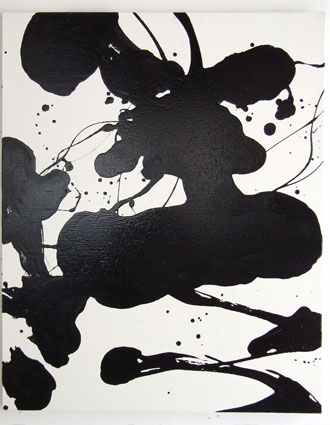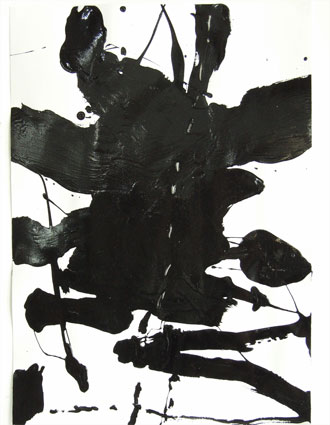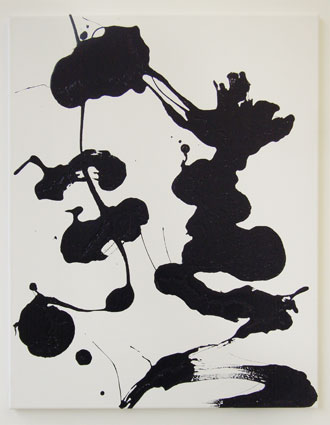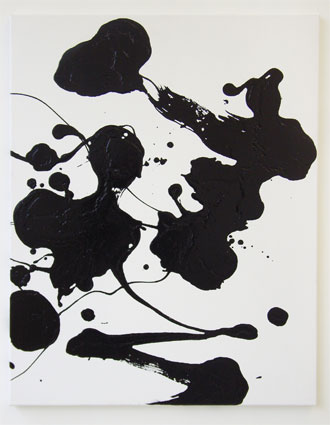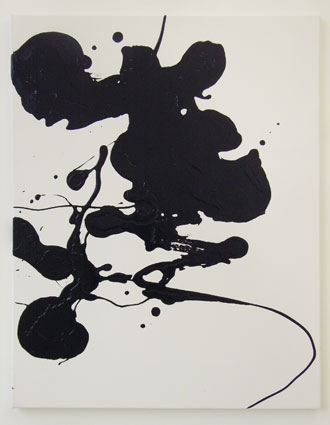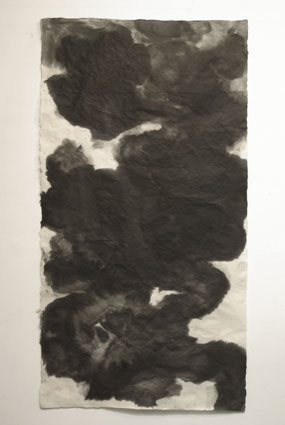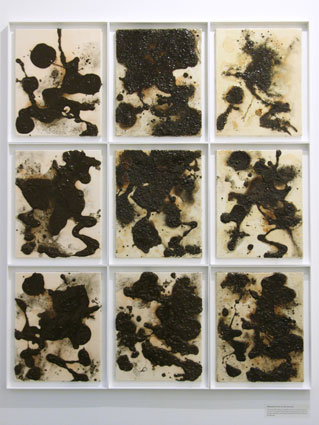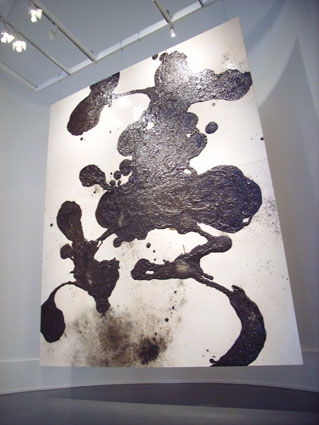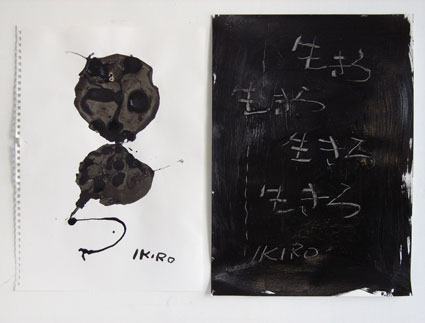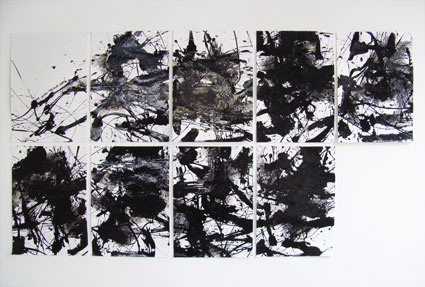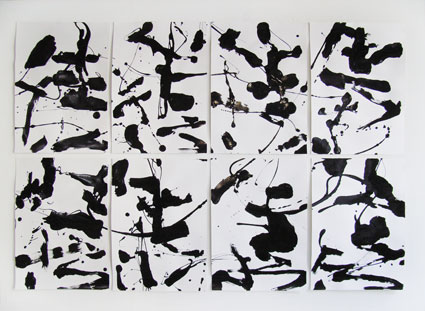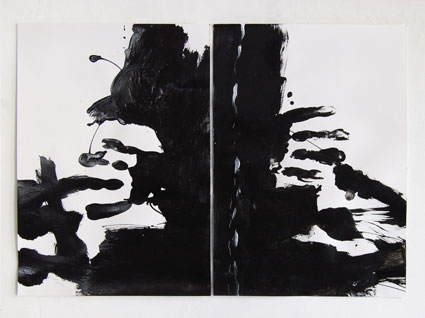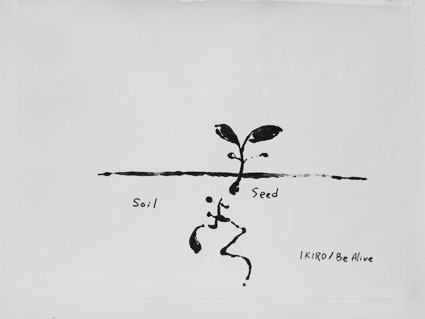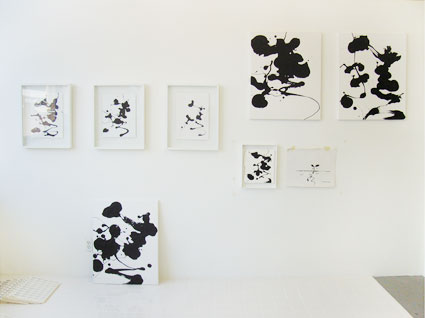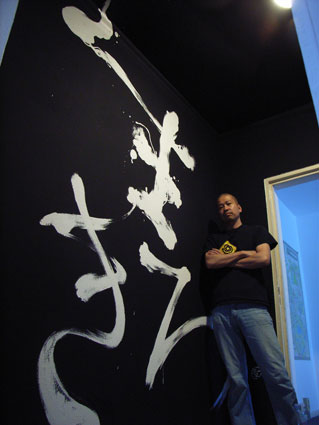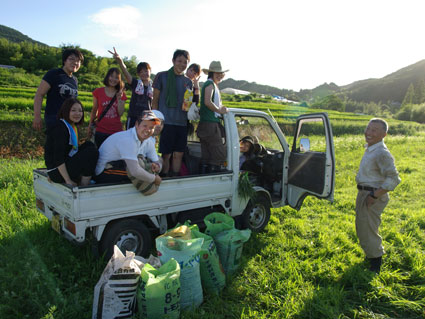This was the first IKIRO performance held outside Japan. Takahiro started writing IKIRO one year before the performance. He simply needed a lot of IKIRO papers for the installation he planned in the park. During the preparation he realized writing IKIRO everyday was as important a routine as the performance itself. It was a special feeling he had never experienced before. He thought this long-term expression could be a life project. The performance in the park lasted for 4 hours. He asked friends to distribute the concept sheets of the performance. Since then he has been writing IKIRO as an art project. Writing IKIRO with IKIRO papers became his performance style.
Website of IKIRO - Be Alive Project / Takahiro Suzuki |

Project 1
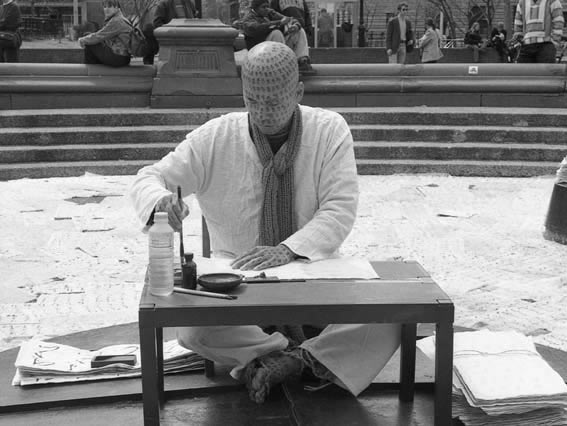
IKIRO in New York - Photo 1
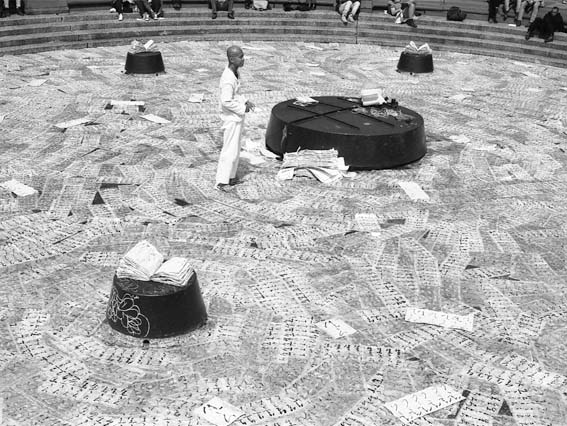
IKIRO in New York - Photo 2
This was the first IKIRO performance held outside Japan. Takahiro started writing IKIRO one year before the performance. He simply needed a lot of IKIRO papers for the installation he planned in the park. During the preparation he realized writing IKIRO everyday was as important a routine as the performance itself. It was a special feeling he had never experienced before. He thought this long-term expression could be a life project. The performance in the park lasted for 4 hours. He asked friends to distribute the concept sheets of the performance. Since then he has been writing IKIRO as an art project. Writing IKIRO with IKIRO papers became his performance style. 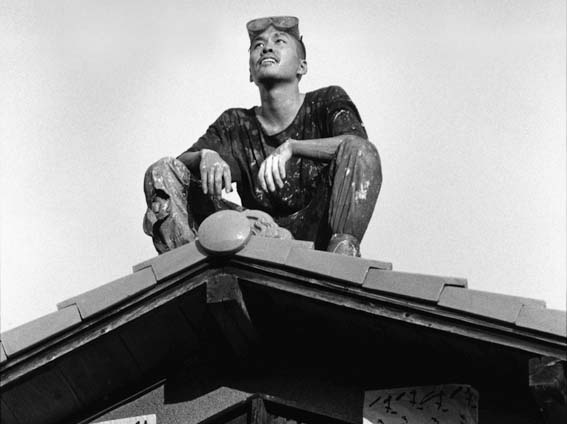
The funeral of IKIRO house - Photo 1
When Takahiro was a child he went to a private art school. In the picture you can see the art school. The man in the framed picture below Takahiro is Ishikawa. He is the father of Takahiro's teacher. Ishikawa already passed away and he was the owner of the house. This exhibition was the collaboration between Takahiro & Ishikawa. In the house there was an exhibition dedicated to Ishikawa's memory. The outside walls were covered with IKIRO paper. Takahiro performed inside and outside of the house to make a connection between the dead and the living. The day after the exhibition, the house was torn down and a few months later a new house was built. It was the last day for this house. 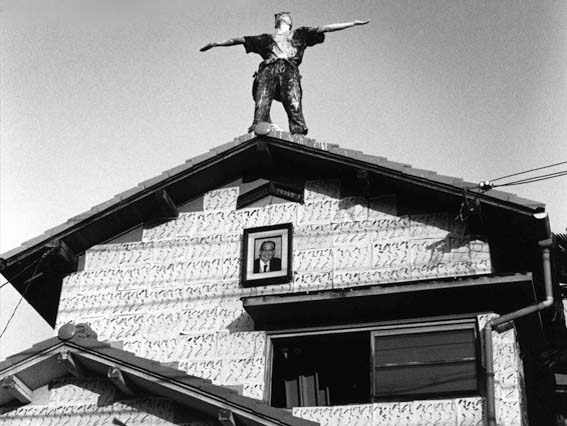
The funeral of IKIRO house - Photo 2
When Takahiro was a child he went to a private art school. In the picture you can see the art school. The man in the framed picture below Takahiro is Ishikawa. He is the father of Takahiro's teacher. Ishikawa already passed away and he was the owner of the house. This exhibition was the collaboration between Takahiro & Ishikawa. In the house there was an exhibition dedicated to Ishikawa's memory. The outside walls were covered with IKIRO paper. Takahiro performed inside and outside of the house to make a connection between the dead and the living. The day after the exhibition, the house was torn down and a few months later a new house was built. It was the last day for this house. 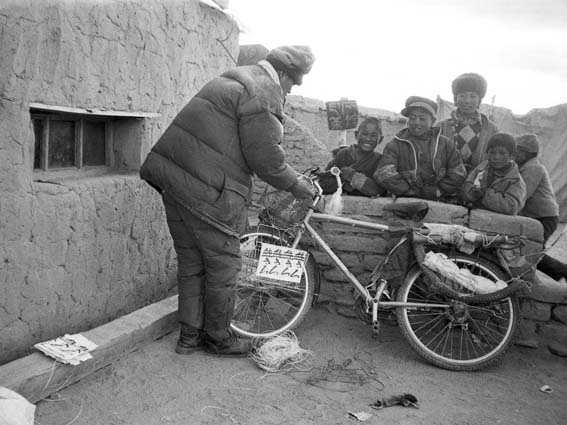
IKIRO in front of Mt. Kailash- Photo 1
When Takahiro traveled in the Takuramacan desert in1996 he met a backpacker who went to Mt. Kailash. The backpacker said, “Going there is very difficult because of the high altitude and bad road condition, sometimes people die on the way there. It is not a matter of you choosing Mt. Kailash, because Mt. Kailash chooses you.” Next year Takahiro visited Mt. Kailash to write “IKIRO” in front of the holy mountain. He started from Lhasa on a bicycle and also hitchhiked to get to Mt. Kailash. It was a really tough trip but on the way to there he learned a lot of things. Since then he has been combining travel and IKIRO performance as an art project. 
IKIRO in front of Mt. Kailash- Photo 2
When Takahiro traveled in the Takuramacan desert in1996 he met a backpacker who went to Mt. Kailash. The backpacker said, “Going there is very difficult because of the high altitude and bad road condition, sometimes people die on the way there. It is not a matter of you choosing Mt. Kailash, because Mt. Kailash chooses you.” Next year Takahiro visited Mt. Kailash to write “IKIRO” in front of the holy mountain. He started from Lhasa on a bicycle and also hitchhiked to get to Mt. Kailash. It was a really tough trip but on the way to there he learned a lot of things. Since then he has been combining travel and IKIRO performance as an art project. 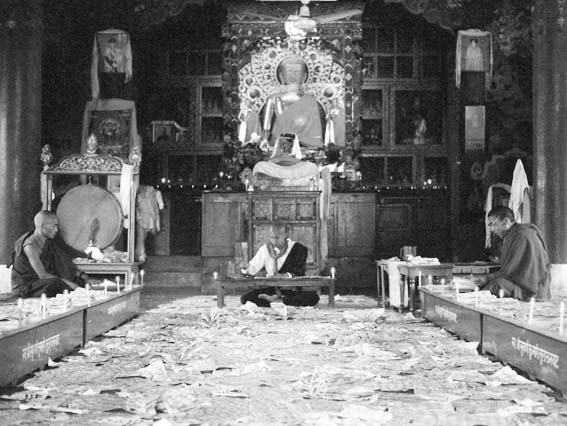
IKIRO in Lumbini
Takahiro traveled in Tibet, India, and Sri-Lanka, and at the end he performed at a Tibetan temple in Lumbin, Nepal where Buddha was born. Takahiro had a collaboration with Buddhist monks for 1 hour. During this performance the monks read scriptures. People could watch this collaboration from outside. Takahiro is not a Buddhist monk but he likes the peaceful idea of Buddhism. Takahiro thinks writing IKIRO itself is a spiritual expression. It's also part of his philosophy. 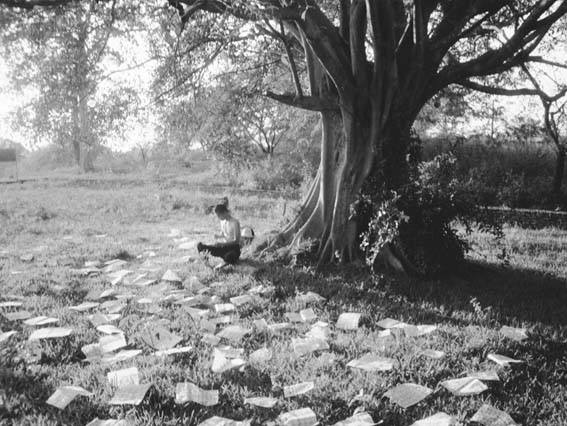
IKIRO in Boronnarwa
Takahiro considered what is the difference between creation and no creation. “Maybe the purest creation is to create nothing.” He went to India and Sri-Lanka to trace the roots of Buddhism, because he thought there might be some clues to the question. His work was not connected to any specific religion, but the idea writing IKIRO everyday is similar to the way people pray. He writes the words IKIRO as a human being. It does not matter which is better - a special writing or praying. Writing IKIRO slowly became a kind of meditation. 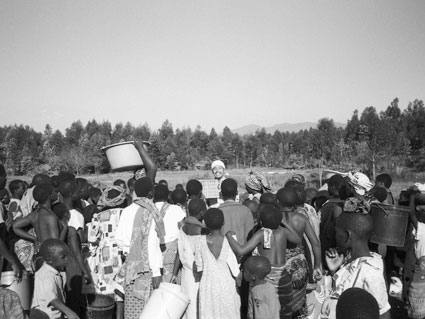
IKIRO in Africa - Photo 1
Takahiro went to some countries in Africa to think about the roots of creation. At that time he was more interested in cultural anthropology than contemporary art. He visited many tribes who are based on primitive living. Their simple way of living inspired Takahiro and the IKIRO project. He sometimes wrote IKIRO in front of the people who were really poor. This bitter experience motivated him to introduce the donation systems in the IKIRO project later. One day he had a collaboration with the Datoga tribe. He pantomimed and wrote IKIRO, and they performed a traditional ritual. It was like exchanging spirits. 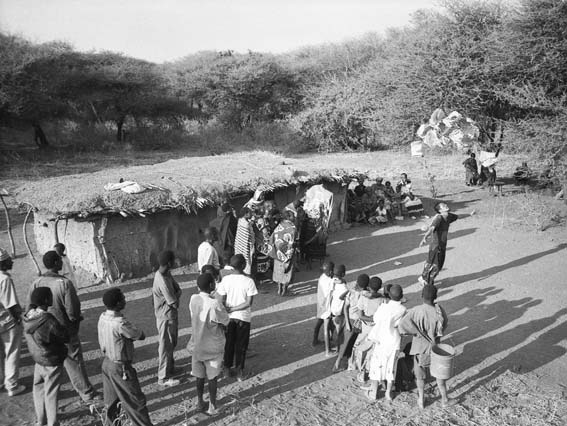
IKIRO in Africa - Photo 2
Takahiro went to some countries in Africa to think about the roots of creation. At that time he was more interested in cultural anthropology than contemporary art. He visited many tribes who are based on primitive living. Their simple way of living inspired Takahiro and the IKIRO project. He sometimes wrote IKIRO in front of the people who were really poor. This bitter experience motivated him to introduce the donation systems in the IKIRO project later. One day he had a collaboration with the Datoga tribe. He pantomimed and wrote IKIRO, and they performed a traditional ritual. It was like exchanging spirits. |
IKIRO Project 1996 - 1998 / Takahiro Suzuki |
Project 2
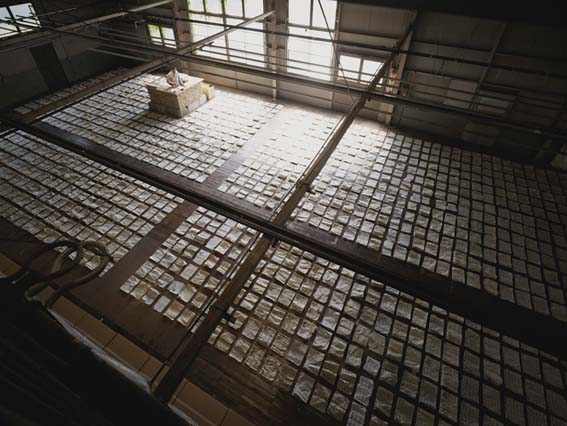
IKIRO Factory - Photo 1
The exhibition "IKIRO Factory" was held in a former traditional Kimono factory. The atmosphere of the exhibition was calm and Takahiro only used natural daylight for the installation. He stood by the desk and kept writing IKIRO quietly. The IKIRO papers he had written in many countries were installed on the floor. This installation became the basic style of the IKIRO project. At that time Takahiro established a temporary Art unit "IKIRO-Junction" with some artists. Visitors were able to go to the cafe in the factory and read books about IKIRO project. Since this exhibition the donation system has been combined with the project. 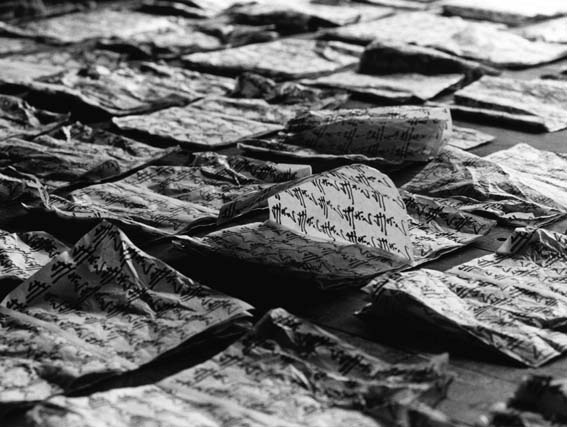
IKIRO Factory - Photo 2
The exhibition "IKIRO Factory" was held in a former traditional Kimono factory. The atmosphere of the exhibition was calm and Takahiro only used natural daylight for the installation. He stood by the desk and kept writing IKIRO quietly. The IKIRO papers he had written in many countries were installed on the floor. This installation became the basic style of the IKIRO project. At that time Takahiro established a temporary Art unit "IKIRO-Junction" with some artists. Visitors were able to go to the cafe in the factory and read books about IKIRO project. Since this exhibition the donation system has been combined with the project. 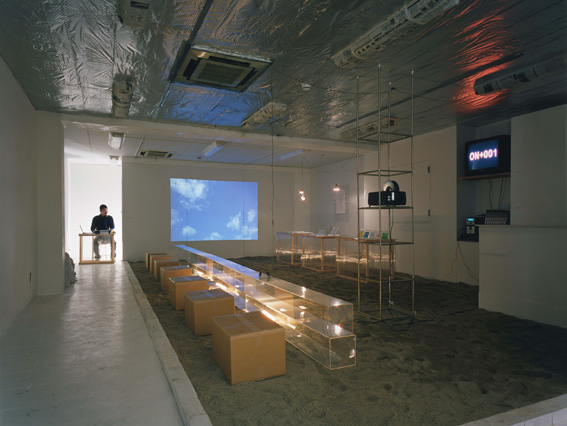
IKIRO Cafe
An art unit IKIRO Junction set up a temporary cafe and sold IKIRO junction goods. Visitors could stay and read some information books about IKIRO Junction. Beside Takahiro, the artists Yoko Kuroda and Shuko Terada; and the architect Yoshiaki Nagasaka were members of this Cafe. Takahiro sat at the corner of the room and typed IKIRO. People could see this action through the Internet. At the end of the exhibition Yoko Iida and Hiroko Nakamura held a dance performance. 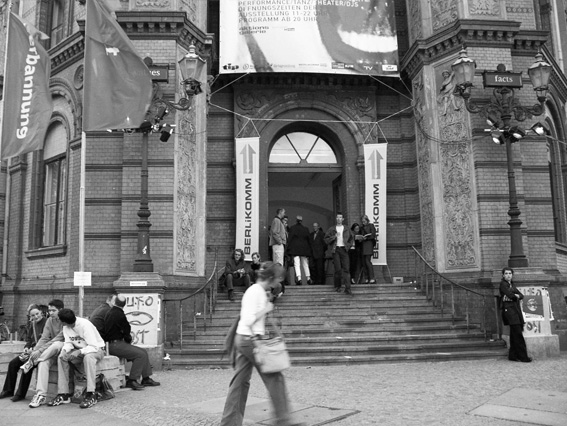
IKIRO in Berlin - Photo 1
Takahiro wrote IKIRO at the entrance of an exhibition called "Undabude Post 2000" in Berlin. This international group exhibition was held for a month. There were many visitors especially at the opening there were more than 3000 people. Every night they had a special music or dance program which attracted many different kinds of people. It was a good experience for Takahiro to see the people's reaction to IKIRO performance, and to know how IKIRO expression works with people as an art project in Europe. It was the first IKIRO project in Europe. 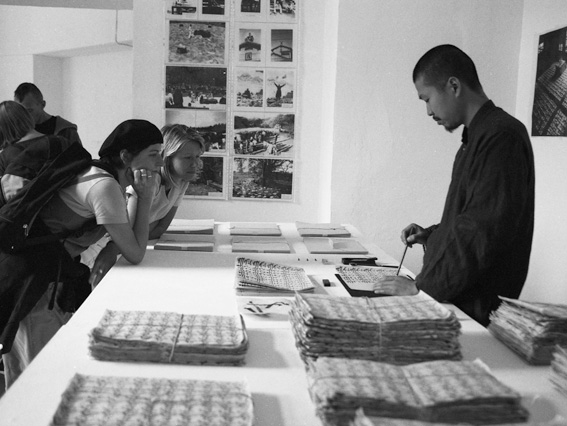
IKIRO in Berlin - Photo 2
Takahiro wrote IKIRO at the entrance of an exhibition called "Undabude Post 2000" in Berlin. This international group exhibition was held for a month. There were many visitors especially at the opening there were more than 3000 people. Every night they had a special music or dance program which attracted many different kinds of people. It was a good experience for Takahiro to see the people's reaction to IKIRO performance, and to know how IKIRO expression works with people as an art project in Europe. It was the first IKIRO project in Europe. 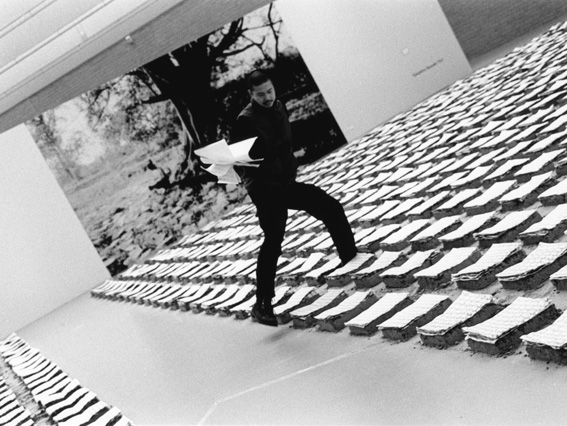
IKIRO in the Kröller-Müller Museum - Photo 1
Takahiro participated in the exhibition at Kröller-Müller Museum in the Netherlands. He made an IKIRO installation in the museum and constantly wrote IKIRO outside of the building surrounded by nature for 5 months. He also made a potato field next to his desk to think about the basic idea of creation. He found similarities between writing IKIRO and planting potatoes. It was also a homage to the painting "Potato eater" by Vincent Van Gogh in the museum. He filmed conversations with visitors sometimes and made a documentary video later. It was the longest IKIRO performance so far inside a museum. 
IKIRO in the Kröller-Müller Museum - Photo 2
Takahiro participated in the exhibition at Kröller-Müller Museum in the Netherlands. He made an IKIRO installation in the museum and constantly wrote IKIRO outside of the building surrounded by nature for 5 months. He also made a potato field next to his desk to think about the basic idea of creation. He found similarities between writing IKIRO and planting potatoes. It was also a homage to the painting "Potato eater" by Vincent Van Gogh in the museum. He filmed conversations with visitors sometimes and made a documentary video later. It was the longest IKIRO performance so far inside a museum. 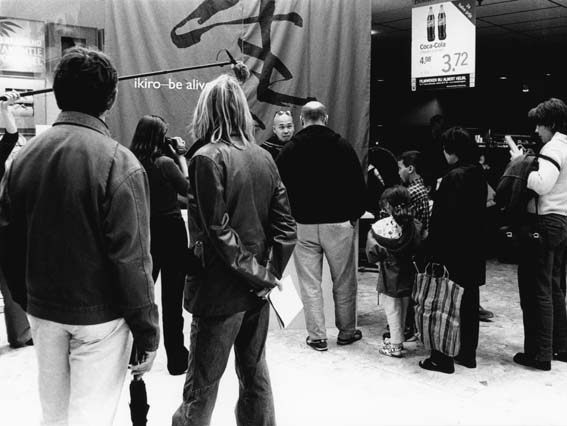
IKIRO at Sonsbeek
Takahiro performed at the opening of the international exhibition, Sonsbeek 9, directed by Jan Hoet. Takahiro was absent from the Kröller-Müller Museum one day to participate in Sonsbeek9. To perform inside the shopping mall was a totally different experience from performing in the museum. He enjoyed the people's reactions in the shopping mall. After the opening he put the documentary video shown on the place were the performance was held in the shopping mall during the whole exhibition. Both locations were shown, the museum & the shopping mall. 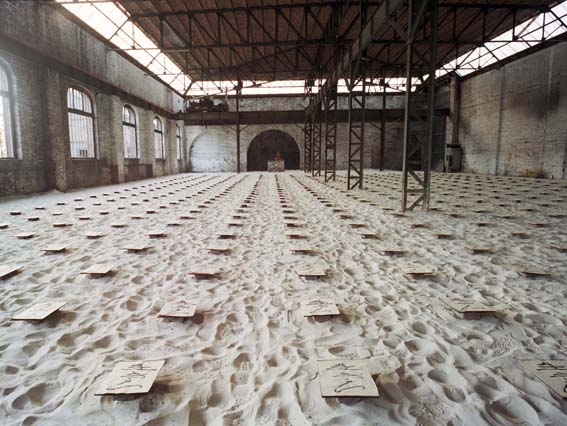
IKIRO in Genk - Photo 1
The city of Genk was famous for the coalmine before they closed it. The exhibition was held for the one hundredth anniversary of the first successful coal digging in this town. The exhibition took place inside the former coal main factory. Takahiro used a huge storage room, called the "Magazijn" with a size of 30 meters by 80 meters, for his installation. He covered the floor with sand. He placed the IKIRO papers on burned wood. These natural materials symbolize the cycle of life and the return to the earth. 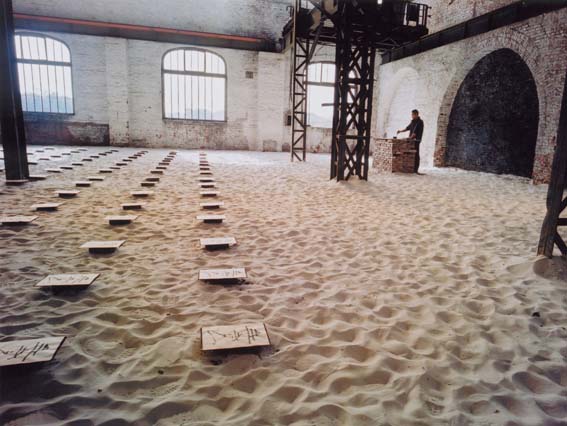
IKIRO in Genk - Photo 2
The city of Genk was famous for the coalmine before they closed it. The exhibition was held for the one hundredth anniversary of the first successful coal digging in this town. The exhibition took place inside the former coal main factory. Takahiro used a huge storage room, called the "Magazijn" with a size of 30 meters by 80 meters, for his installation. He covered the floor with sand. He placed the IKIRO papers on burned wood. These natural materials symbolize the cycle of life and the return to the earth. |
IKIRO Project 1999 - 2001 / Takahiro Suzuki |
Project 3
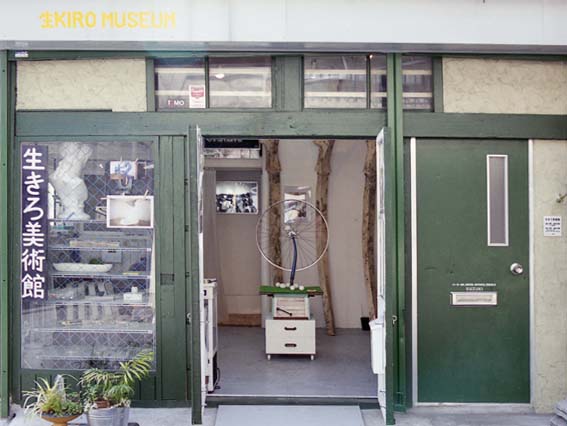
IKIRO Museum
Takahiro opened the IKIRO Museum, very small and located on the 1st floor in his apartment. The apartment was a very old style house but in the center of Osaka. It took nearly one year to renovate, and his friends helped him to open the museum.
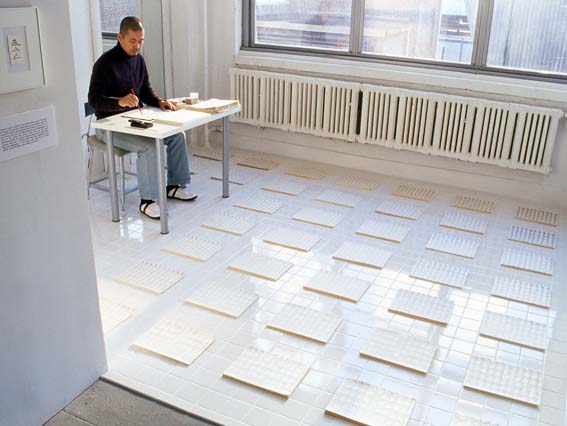
IKIRO Room
Takahiro took the program of ISCP (International Studio & Curatorial Program) in New York and kept writing IKIRO and also painted IKIRO constantly. He put tiles on the floor and 2 mirrors on the wall for the installation. Takahiro had different feelings from his time in New York in back in 1996. He thought time really changes day by day, especially in a big city like New York or Tokyo. While he was in the program many people visited his studio and talked about the IKIRO Project. 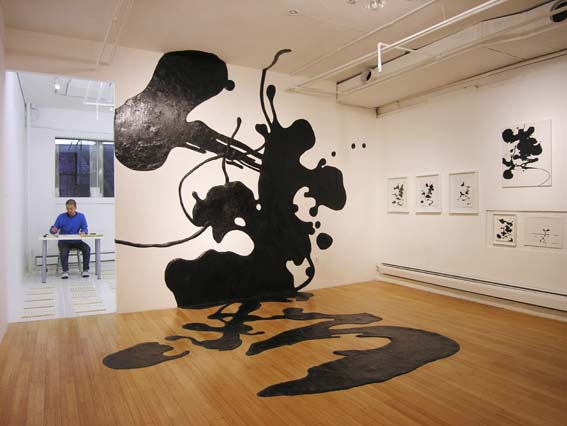
IKIRO Painting
Shinnie Kim who is a Program’s Manager of ISCP organized the exhibition. Takahiro made a big IKIRO painting on the wall and the floor in the gallery. Takahiro stayed at the gallery and kept writing IKIRO and sometimes talked to the visitors. After this exhibition he moved to Berlin and lived there for 3 years. 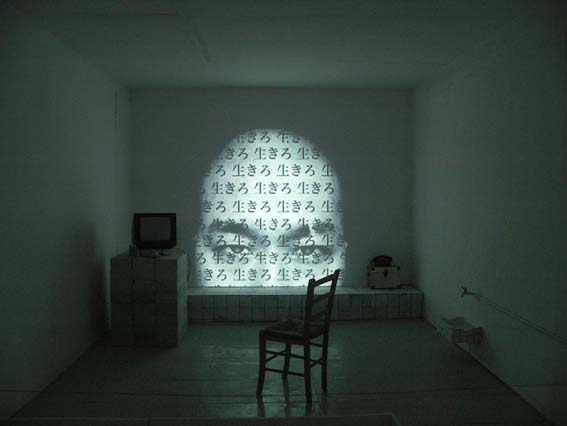
IKIRO in Hong Kong
It was an exchange residence program of Japanese artists, and artists from Hong Kong. Takahiro stayed in Hong Kong for few days and collected the material and made his work. Takahiro showed a video installation of IKIRO in the room. He took the idea for the video from the end roll of a Hong Kong movie. He also made a Hong Kong-styled "IKIRO" wall outside. It was a group show with Yoshiaki Kaihatsu, Shiro Masuyama and Atsuko Arai. 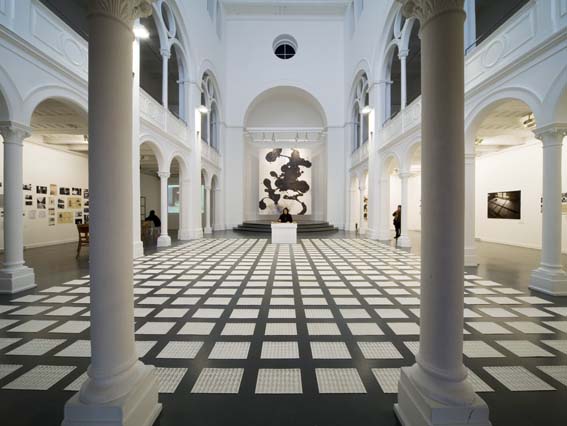
IKIRO at Bethanien - Photo 1
This exhibition was held at Kuenstlerhaus Bethanien GmbH Studio 1, which was used as a church before. Takahiro performed writing IKIRO and exhibited an installation with sheets of IKIRO paper, a big IKIRO painting made from the soil of Bethanien, IKIRO drawings, photos of the IKIRO project. He also showed a video of 1970's Bethanien and photos of 160 years Bethanien history. There was an interview video of Michael Haerdter (the former director of Kuenstlerhaus Bethanien) and Dietlinde Peters (a member of Kreuzberg Museum) at the exhibition. Takahiro were also in the international studio program of Kuenstlerhaus Bethanien for one year. 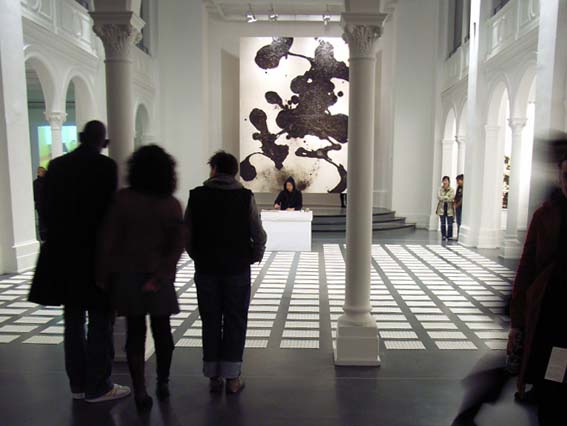
IKIRO at Bethanien - Photo 2
This exhibition was held at Kuenstlerhaus Bethanien GmbH Studio 1, which was used as a church before. Takahiro performed writing IKIRO and exhibited an installation with sheets of IKIRO paper, a big IKIRO painting made from the soil of Bethanien, IKIRO drawings, photos of the IKIRO project. He also showed a video of 1970's Bethanien and photos of 160 years Bethanien history. There was an interview video of Michael Haerdter (the former director of Kuenstlerhaus Bethanien) and Dietlinde Peters (a member of Kreuzberg Museum) at the exhibition. Takahiro were also in the international studio program of Kuenstlerhaus Bethanien for one year. 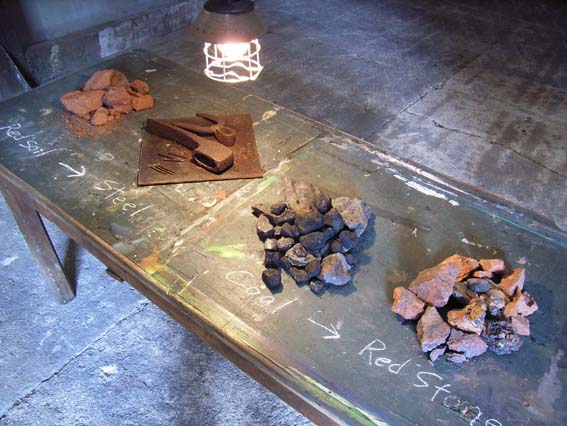
IKIRO in Saarland - Photo 1
This Exhibition was held at Volklingr Steel factory, which was the biggest steel factory in Germany. Now it is a UNESCO site. Takahiro traced the history of this factory. He used the red soil of Luxemburg and coal of Volklingr to make IKIRO on the grand. These were the exact same materials that people used in the factory to produce steel. Takahiro stayed there for 10 days to make the installation. After Takahiro left the space, people could step on the installation so that the 2 colors of IKIRO would be mixed together little by little. This process stood for making no border between the countries. Volklingr was sometimes part of France and sometimes part of Germany throughout its history. 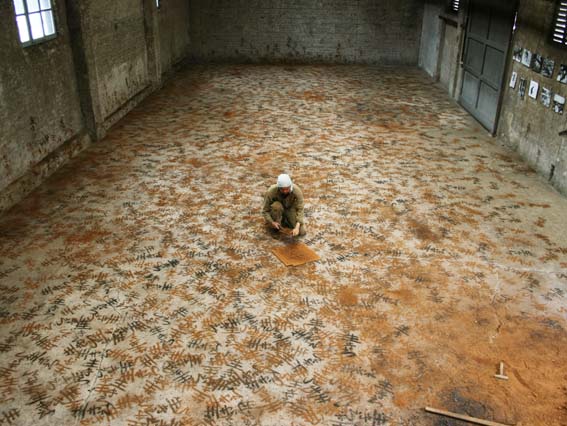
IKIRO in Saarland - Photo 1
This Exhibition was held at Volklingr Steel factory, which was the biggest steel factory in Germany. Now it is a UNESCO site. Takahiro traced the history of this factory. He used the red soil of Luxemburg and coal of Volklingr to make IKIRO on the grand. These were the exact same materials that people used in the factory to produce steel. Takahiro stayed there for 10 days to make the installation. After Takahiro left the space, people could step on the installation so that the 2 colors of IKIRO would be mixed together little by little. This process stood for making no border between the countries. Volklingr was sometimes part of France and sometimes part of Germany throughout its history. 
IKIRO in Cork - Photo 1
It was held in a former factory. Takahiro made a big ship shape with the material he found in the factory. He hung IKIRO papers in the ship and put the marks of "SEI ", which is a part of IKIRO letters on the ground with straw. Mick O'Shea is a visual/sound artist whose collaboration with Takahiro took the form of a non-verbal conversation where the vocabulary element was the amplified writing of IKIRO and sampled sounds taken from the space and the local environment. The manipulated sounds were played back into the space and improvised so sound and writing are in dialogue. 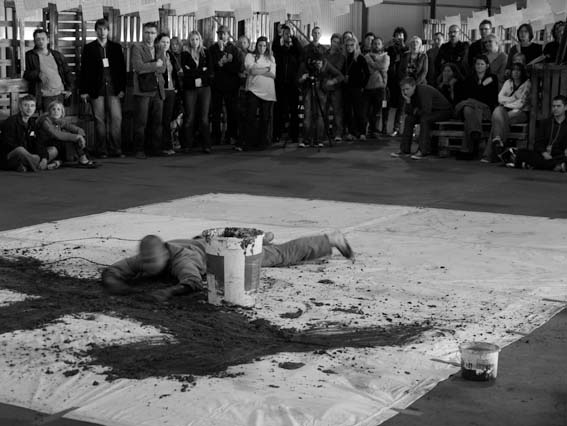
IKIRO in Cork - Photo 2
It was held in a former factory. Takahiro made a big ship shape with the material he found in the factory. He hung IKIRO papers in the ship and put the marks of "SEI ", which is a part of IKIRO letters on the ground with straw. Mick O'Shea is a visual/sound artist whose collaboration with Takahiro took the form of a non-verbal conversation where the vocabulary element was the amplified writing of IKIRO and sampled sounds taken from the space and the local environment. The manipulated sounds were played back into the space and improvised so sound and writing are in dialogue. |
IKIRO Project 2002 - 2008 / Takahiro Suzuki |
Project 4
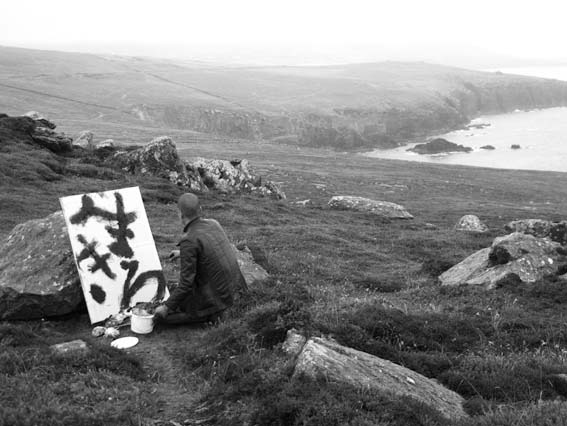
IKIRO - Evanescent
Takahiro painted with the peat moss he took from nature in Dingle. He also did an action throwing the IKIRO papers with fire. Takahiro got a strong inspiration from the countryside in Dingle. He also felt he is a part of nature and life is limited.
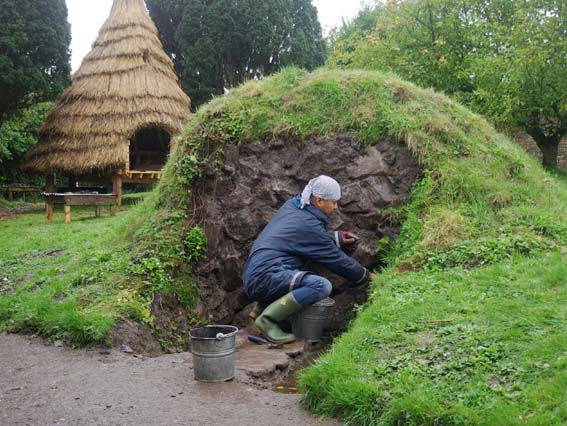
IKIRO for the Future
This is a 2 person exhibition. The exhibition title is "Aireagla´n" which means a small hermitage. It comes from a poem from the Middle Ages in Ireland. Takahiro made a Japanese ancient style tomb at the backyard of Failte Roimh Church. There are IKIRO art works in side of the tomb. Takahiro also put 5 letters for the future inside. 5 letters were written by An t O´ll Padraig O´ Fiannachta, T.P.O´ Concu´blair, Sister De Sales Dforgan, Caoimhghin O´ Fraithile, Takahiro Suzuki. People can see inside through a hole. This work stays as a permanent exhibit. 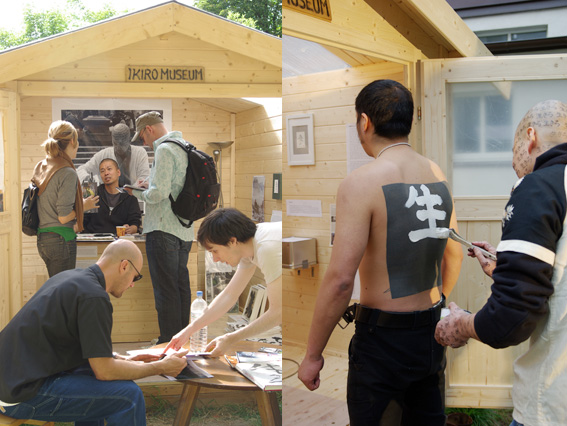
Life Project
Takahiro and Hironari Kubota, two Japanese artists performed together. It was an exhibition about the exchanging spirit and energy of the two artists.
Hironari is an artist who created a sculpture of a rotating car, and performs with Japanese music.
Takahiro kept writing the word IKIRO throughout the exhibition at the IKIRO Museum he made.
Takahiro and Hironari had a kind of ritualistic performance together. For example Takahiro wrote IKIRO on Hironari's body before his Trabant's performance. 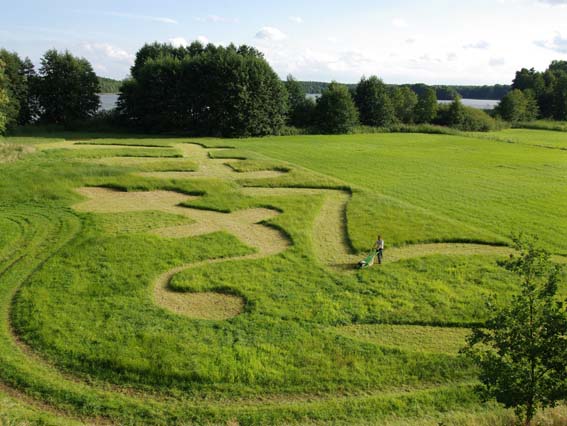
IKIRO for the Nature
There were three IKIRO Museums in the world. The first museum was in Osaka. The second one was at Theaterhasu Mitte in Berlin, and the last one was in Schuesshof. The IKIRO Museum in Schuesshof was surrounded by a lot of nature. This picturesque place was an ideal for an IKIRO Museum. It is located at a seminar house, organized by Takahiro's friends Gerd Barnewitz and Cristina Biaggi B. The IKIRO project was dedicated to nature in Schluesshof for a special exhibition. In order to leave a message for the future, Takahiro sank IKIRO ceramic works made by the technic of primitive age. Takahiro also made a big IKIRO sign on the field. 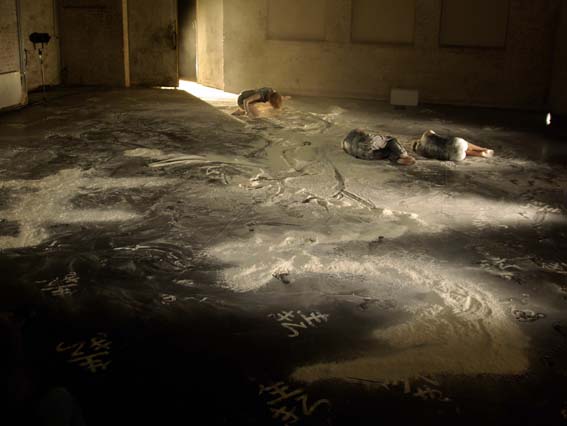
IKIRO at Dock 11
Takahiro had a performance with contemporary dancers on the stage. Takahiro made shapes of IKIRO with a stencil and wheat. He spread the IKIRO little by little during the show. Some of the IKIRO disappeared with the dancers and some of them were left. The impression of the stage was changed black to white by the phenomenon IKIRO became wheat powder. At the end Takahiro made a big IKIRO on the stage with his action. 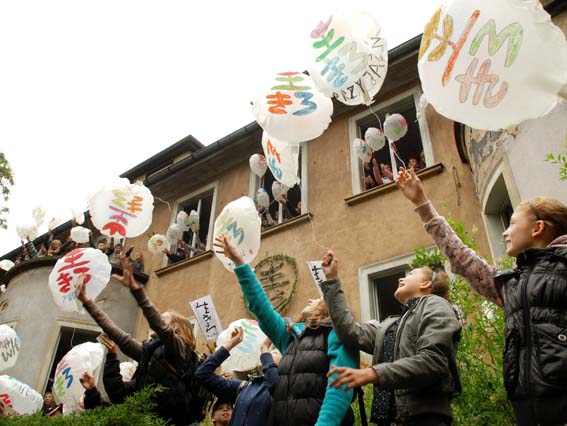
IKIRO with 100 Children
Takahiro did a workshop and held an event with 100 children, teachers and staff at a former orphanage in Gorzow in Poland. Each balloon had colorful IKIRO signs and a one-word message written by each child. On a signal from Takahiro 100 balloons flew in the sky at the same time. Children gave shouts of joy. This experience gave him a new feeling for the IKIRO Project. He thought everyone could share the energy of the word IKIRO with this kind of workshop. 
IKIRO with Boys & Girls
Takahiro has been doing IKIRO workshops with people. In his workshop usually he gives a lecture with IKIRO documents, then people write IKIRO. They write 2 times, and they get one sheet of IKIRO, and one is kept for the IKIRO Project as a document. After the workshop people put their own IKIRO sheets in their houses or offices, then people will get energy or inspiration from them. Takahiro thinks these IKIRO have special meaning for people because they wrote the words IKIRO by themselves. 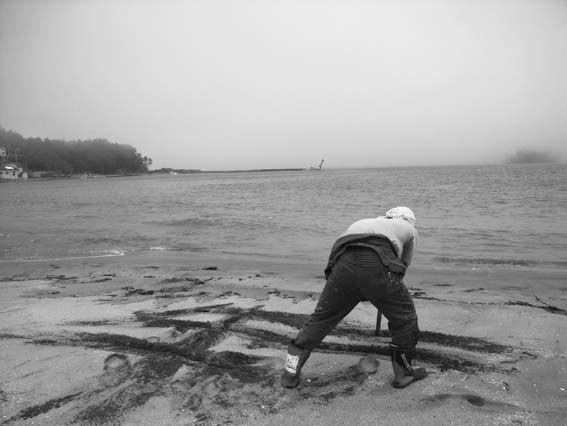
IKIRO in Kesennuma
Takahiro worked as a volunteer for a week in Kesennuma Miyagi which got damaged by the earthquake and Tsunami on March 11, 2011. The reconstruction of this area is still going on. One day Takahiro went to Kesennuma Osima which also suffered the Tsunami. He removed rubble with other volunteers there. During break time he went to a beach and drew IKIRO on the beach. He felt life is tough sometimes. He reflect on the IKIRO Project at the beach quietly and he also thought he goes with the word "IKIRO" in this world. 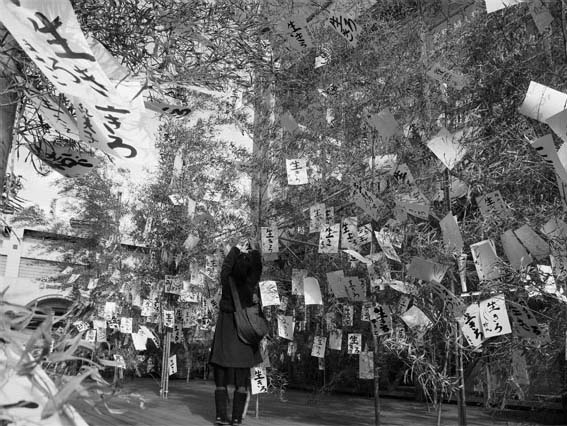
IKIRO Forest
On January 17, 1995 there was the Kobe-Awazi earthquake disaster. The people who got damage at Nishinomiya shopping street at that time made IKIRO Forest for prayer, with IKIRO papers written by participants. There were 3 prayer events organized by Ebisu street team & Takahiro, and this attempt will continue in the future. The students of Imazu High School, Mukogawa Women's University, Hmawaki junior high school also participated in this project the last 3 times. 50 bamboo branches were installed at the stage and more than 3000 people wrote IKIRO on the sheets of paper and hung them on the branches. 
IKIRO for 15 Years Anniversary
The Japanese word “IKIRO” consists of a Chinese character “生”and 2 Japanese Hiragana letters. The origin of the letter “生” comes from China more than 3000 years ago. This time Takahiro made an IKIRO installation on the floor with 2 materials at the opening. One was the red soil from 53 Museum in China. The other one was white wheat flour from Japan. Both colors stand for the flags of China and Japan. Two materials mixed on the floor and become one installation. The IKIRO project documentatary video was on the wall in the room. The day April 1, 2012 was the 15th anniversary for IKIRO project. |
IKIRO Project 2008 - 2012 / Takahiro Suzuki The day April 1, 2012 was the 15th anniversary for the IKIRO project. The style of the IKIRO project has not changed a lot in 15 years. On the other hand a lot of things happened and changed in this world over the last 15 years. The more Takahiro writes IKIRO, the less reason there is for him to do it. This is what he can say and it really doesn't matter if he can find a good meaning to write IKIRO in his life. Writing IKIRO is still mysterious for him and he thinks there are lots of things we never know. Therefore Takahiro keeps writing IKIRO throughout his life. |
Painting
IKIRO Painting 2005- 2008 / Takahiro Suzuki Takahiro paints IKIRO. He uses Acrylic or Japanese Ink or Soil to paint. He thinks he was inspired by Jackson Pollock, more than Japanese calligraphy. Takahiro made many kinds of paintings before he started IKIRO Project. You can see some photos of the paintings on this website. You can also see the photos of his recent concrete paintings on this website. |
Video
IKIRO Project 1996 - 2012 / Takahiro Suzuki Video of IKIRO Project / 12 minutes |
© Takahiro Suzuki, all rights reserved
